How to Test the Silk PLA
By Eryone QC,Andy Wen
The inspiration of silk PLA comes from a textile in daily life, silk. Silk is a kind of glossy, colorful, smooth and delicate textile, while the silk PLA has the same texture with the real silk.
The realistic silk texture and glossy surface effect that weaken the laminated striation.
Silk Fabrics
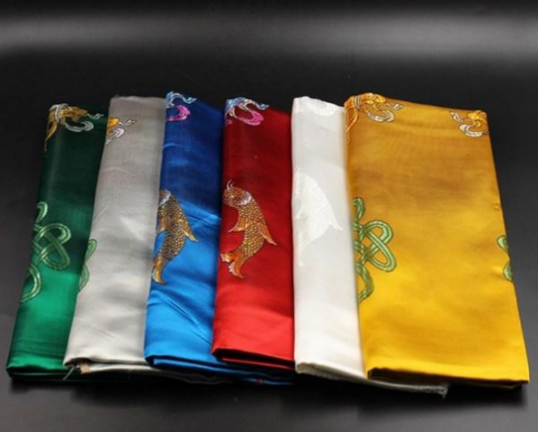
Silk PLA
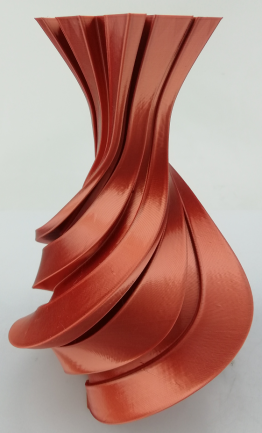
The silk PLA has two series: Ultra silk PLA and standard PLA. Both of them are developed base on the standard PLA, added with TPU raw material. The physical property of silk PLA decides the performances of silk PLA prints, including toughness, shrink rate, water absorbency, printing temperature and so on.
|
Silk PLA Parameters |
||
|
physical properties: |
Typical Value: |
Method: |
|
Peak melt Temperature: |
155℃±5℃ |
ISO 11357 |
|
Glass Transition Temperature: |
60℃ |
ISO 11357 |
|
MFR[g/10min](1):210℃ / 2.16KG |
6g/10 min |
ISO 1133 |
|
Specific Gravity[g/cm3]: |
1.24 g/cm³ |
ISO 1183 |
|
moisture absorption 24hr[%](2) : |
≤500 ppm |
/ |
|
Heat Deflection Temperature(0,45MPa): |
60℃ |
ISO 75 |
|
Tensile Yield Strength Filament[MPa]: |
65 Mpa |
ISO 527-1 |
The parameters in the above table are measured by professional testing instruments.
Diameter and Tolerance
Diameter and tolerance are the very basic parameters that we must know before our test.
And high precision of filament can make a constant diameter and make filament hardly get clogged. After testing via a micrometer, we know the diameter of silk filament is 1.75mm with a tolerance ±0.03.
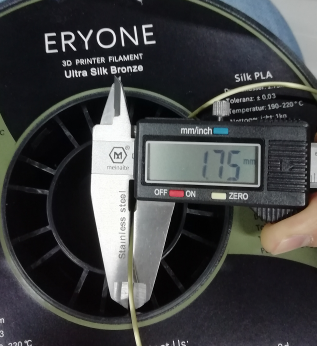
|
Test Object |
Silk PLA |
Test Contents |
Diameter and Tolerance |
Time |
2020 |
Testing Tool |
Micrometer |
Test Method |
A test point for every 30cm. There are 12 testing points. |
|||
|
Color |
Data 1 |
Data 2 |
Data 3 |
Data 4 |
Data 5 |
Data 6 |
Data 7 |
Data 8 |
Data 9 |
Data 10 |
Data 11 |
Data 12 |
|
Ultra Silk Bronze(mm) |
1.75 |
1.74 |
1.76 |
1.75 |
1.75 |
1.74 |
1.74 |
1.76 |
1.74 |
1.73 |
1.75 |
1.74 |
|
Ultra Silk Copper(mm) |
1.73 |
1.77 |
1.75 |
1.76 |
1.75 |
1.75 |
1.76 |
1.74 |
1.75 |
1.75 |
1.76 |
1.74 |
|
Standard PLA Copper(mm) |
1.75 |
1.74 |
1.76 |
1.75 |
1.74 |
1.73 |
1.75 |
1.76 |
1.77 |
1.76 |
1.75 |
1.76 |
From the testing data in the table, there are 12 test points for filaments in each color. There is a 30cm distance between the two test points. As is the micrometer shown, the 12 date indicate that the filaments have reached the high precision 1.75±0.03mm. So silk PLA filament meets the standards of the diameter.
Temperature Property
As we know, PLA filament is user-friendly for our beginners because it’s easy to use.
Silk PLA filament, as it’s developed based on standard PLA material, also can be very user-friendly. To get a wonderful print, we must make sure that we know the printing temperature well. The printing temperature directly influences the constant diameter and the liquidity of the output filament. Let’s have a look at the printing effects at certain temperature points within 190-220℃.
|
Test Object |
Silk PLA |
Time |
2020 |
|
Test Method |
Printed objects produced at different temperature points. |
||
|
Color |
196℃ |
205℃ |
220℃ |
|
Ultra Silk Bronze |
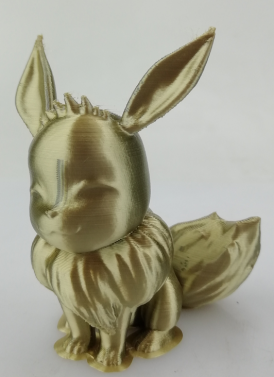 |
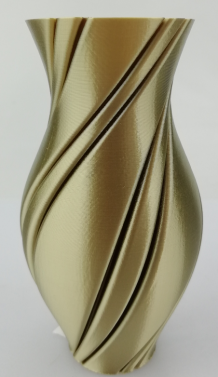 |
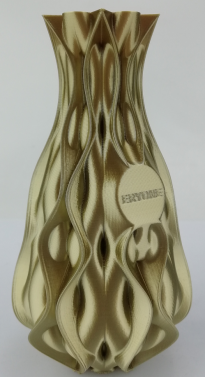 |
|
Ultra Silk Copper |
|
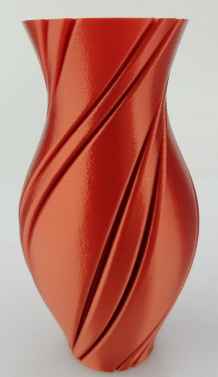 |
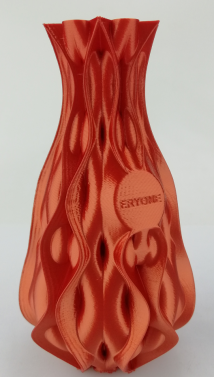 |
|
Standard Silk Copper
|
|
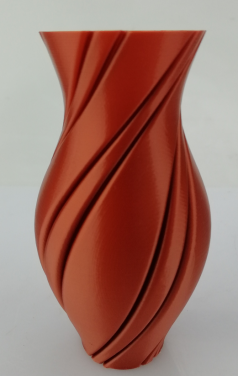 |
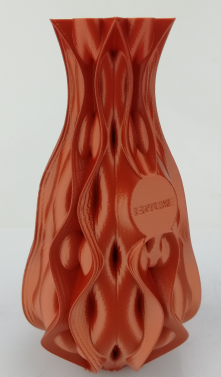 |
|
Ultra Silk Black |
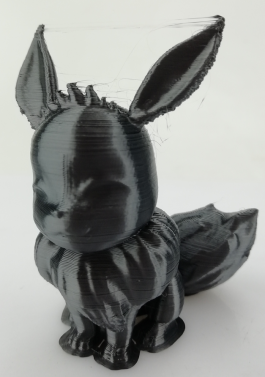 |
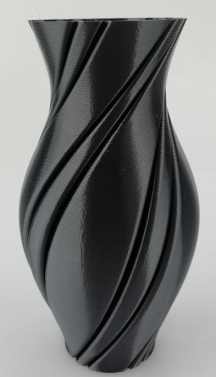 |
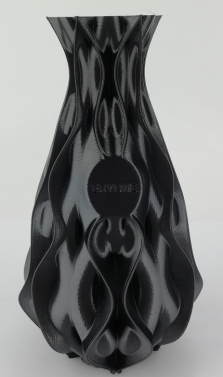 |
Under three temperature points 196℃, 205℃ and 220℃, we test the printing effect and that effect is very pleasant. When we set reasonable slice parameters, the prints have smooth surface, fine fluidity, no clogging but have much string. Therefore, when the temperature ranges 190-220℃, the silk PLA filament can reach a high-quality printing effect.
Matching Rate of Speed and Temperature
The matching rate of speed and temperature is also an factor that affects the printing effect. Also, it reflects how customers get familiar with the slicing of this matte filament.
We choose 3 temperature points to test. At a certain temperature, we set different printing speed as the print gets higher. In this way, we can find the optimal match of temperature and speed.
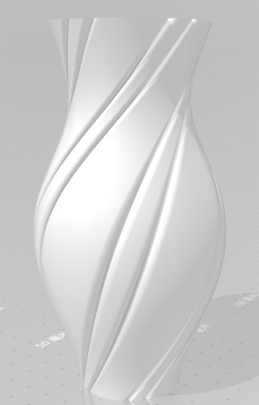
|
Test Object |
Silk PLA |
Time |
2020 |
Test Method |
In accordance with constant temperature and inconstant speed, we choose 3 temperature points to find that in which speed the prints get the best printing effects. |
|
|
Pinter Type |
Ender 3 |
prusa i3 |
CR-10 |
Thinker SE |
ER-20 |
mega-s |
|
The temperature matches the speed |
195℃:≤35mm/s; |
195℃:≤50mm/s; |
195℃:≤35mm/s; |
195℃:≤35mm/s; |
195℃:≤40mm/s; |
195℃:≤35mm/s; |
The table above shows the optimum matching rate of speed and temperature on mainstream printers. We can refer to the table above to slice. For Silk PLA, the speed should be lower. In this way, the prints will have smoother surface but less string.
The Adhesivity of the Heated Bed
The Silk PLA is similar to other PLA filaments in that they have lower temperature requirements for heated beds. The following are the temperature requirements for common heated beds.
|
Test Object |
Silk PLA |
Time |
2020 |
Test Method |
Print on the different type of bed to test the sticking temperature |
|
Bed Type |
PEI Flexible Bed Adhesive |
Glass Bed |
Microporous Coated Glass Bed |
PEI Bed Adhesive |
Ink-coated Glass Bed |
|
Sticking Temperature |
55-65℃ |
65-70℃ |
60-65℃ |
55-65℃ |
60-65℃ |
We can know from the table that silk PLA has a high compatibility with the mainstream heated bed.
Compatibility of 3D Printers
Without a printer, the filament can not produce a print. The compatibility of the printer should also be taken into concern.
|
Test Object |
Silk PLA |
Time |
2020 |
Test Method |
Print via mainstream printers |
|
Test Color |
Ultra Silk Bronze, Ultra Silk Copper, Standard Silk Copper |
||||
|
Test Type |
Thinker SE、CR-10、Ender 3、Mega-s、ER-20、Prusa i3 |
||||
|
Result |
Within 190-220℃, the above printers can print normally and for the specific recommended parameters, you can refer to the specification. |
||||
From the above test process, Silk PLA filament applies to most FDM printers in the market. When you use different printers, the slicing parameters should be different. The retracting length set for Bowden and direct drive printers should be different. That will be given in the product specification and you can refer it.
Retracting and String
Generally speaking, proper retracting value can decrease retracting. After a few times of testing, we get the following data. As depicted in the picture below, the proper retracting value decreases string rate. The prints shown in the picture are printed by Ender3 according these parameters: printing temperature 205℃, retracting length 4mm, retracting speed 70mm/s.
After comprehensive testing of the above projects, we give you reference of parameters—Bowden extruder printer: printing temperature 200-220℃, retracting length 4-6mm, retracting speed 60-70mm/s; direct-drive extruder printer: printing temperature 200-220℃, retracting speed 1-2 mm, retracting speed 35-40mm/s.

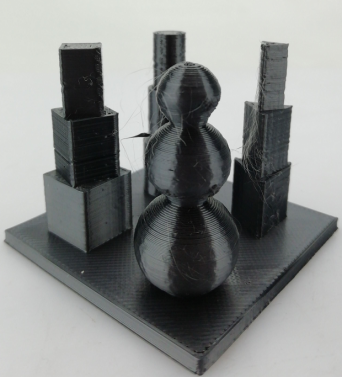
In conclusion, we find that silk PLA (represented by ultra silk copper, ultra silk black, ultra silk copper and silk copper) has a realistic silk texture, high glossiness but no laminated striation.
In terms of printing habits and usage, the silk PLA has no different from the standard PLA and it also can be user-friendly.
Comparison between Ultra Silk PLA and Silk PLA
Silk Copper Ultra Silk Copper
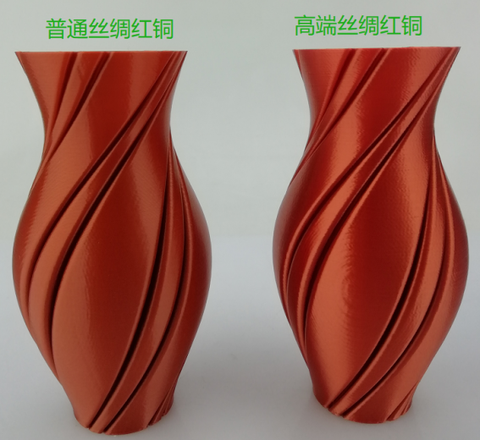
Similarities: Realistic silk texture & color, easy to print, good surface effect, no laminated striation.
Differences: Ultra silk has higher gloss and stronger silk texture.
Note:
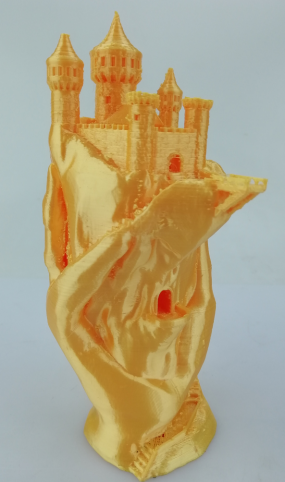
The castle is printed with ultra silk gold PLA. It has realistic silk texture and glossy surface effect that weaken the laminated striation. But if we take a closer look, we may find there is still some part with bad effect. Is that the result of uneven melted filament? No. The main ingredient of silk PLA doesn’t only include PLA. The imperfect effect demonstrates that the ultra silk doesn’t fit to print the objects with too high resolution ratio. On the whole, the printing effect of silk PLA is pretty good.
Ultra Silk Copper Silk Copper Standard PLA Red
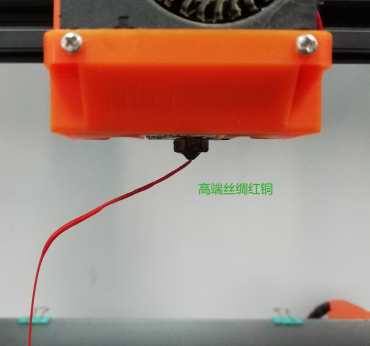
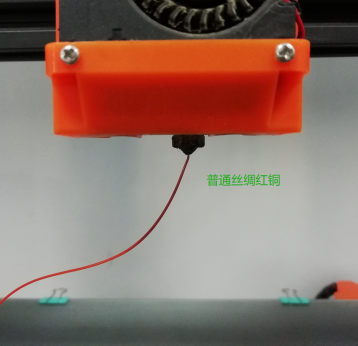
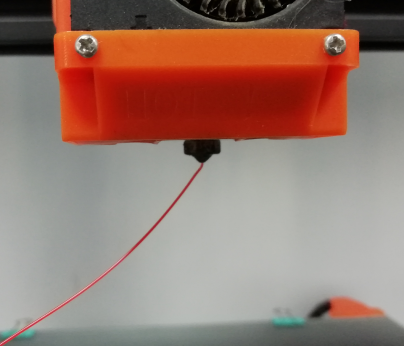









































































Hello! Can you tell me what to do with the poor sinterability of the layers? I print PLA ERYONE Chopper Silk in the “vase” mode, temperature 220 degrees, blowing 20%, speed 20 mm/min. The part breaks very easily and crumbles in the form of threads.
] Bamitiyud xfa.todx.eryone3d.com.knu.qc http://slkjfdf.net/
] Adisada zbt.roeb.eryone3d.com.mub.ob http://slkjfdf.net/
] Oaqane ioi.fomj.eryone3d.com.hef.ck http://slkjfdf.net/
] Ozinoveyi gem.xvee.eryone3d.com.mdp.tf http://slkjfdf.net/